Excerpts from Jim Conrad's
Naturalist Newsletter
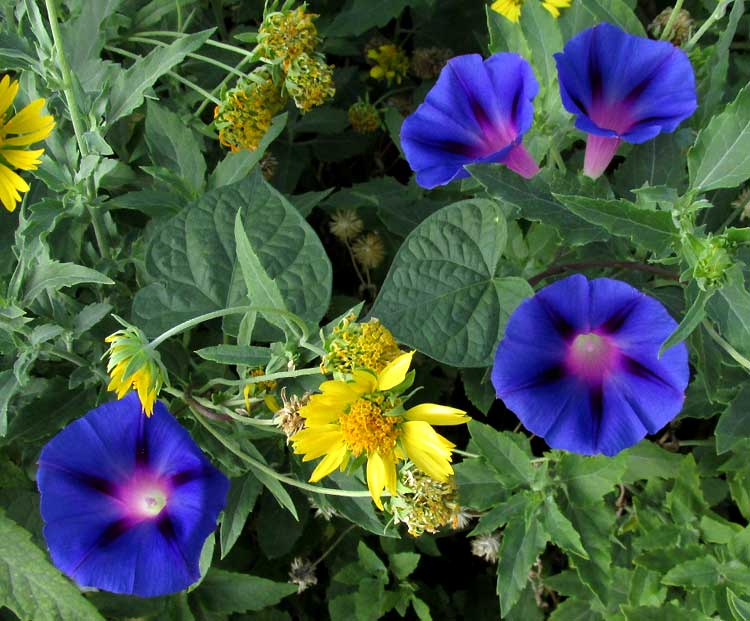
from the August 10, 2014 Newsletter issued from the Frio Canyon Nature Education Center in the valley of the Dry Frio River in northern Uvalde County, southwestern Texas, on the southern border of the Edwards Plateau; elevation ~1750m (~5750 ft); N29.62°, W99.86°; USA
PURPLE MORNING-GLORY
This week a genuine morning-glory sonata turned up in a pretty thicket of Cowpen Daisies next to the house of my neighbor Phred, shown above. Note the heart-shaped leaves. The vividly blue blossoms were about two inches across (5cm) with white eyes fringed with a kind of day-glow pale purple or lavender.
This species is not normally found growing wild in this part of the world, though that's what it seemed to be doing among Phred's wild daisies. However, last year Phred sowed around his house a package of seeds marketed as a "morning-glory mix." This resulted in lots of morning glories with flowers of various colors twining prettily among his sunflowers. I suspect that the ones we're looking at now must be "volunteers" from seeds that somehow traveled a few feet from their parent vines, and this year have been encouraged by Phred's frequent waterings of his wild daisies. As such, probably they're more "cultivated" than "wild growing."
Hundreds of viny species known as morning glories are scattered among various Morning Glory Family genera, and sometimes it can be hard to identify a plant to species. Therefore, to be sure about what you have, you must "do the botany." Below, you can see one of our flower's white, slender, funnel-shaped corolla tubes:
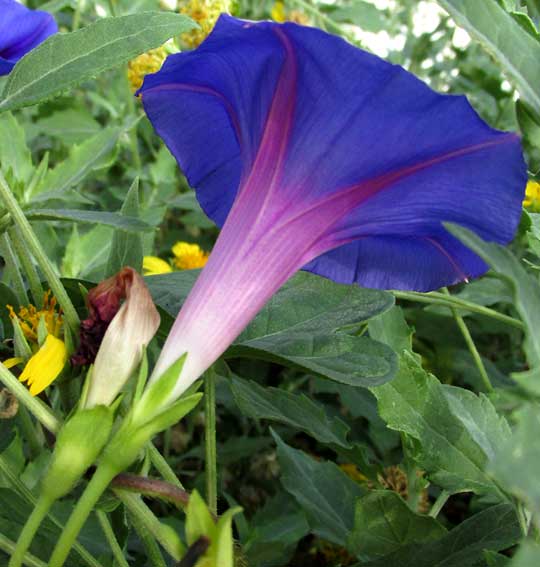
A closer look at the calyx is shown below:
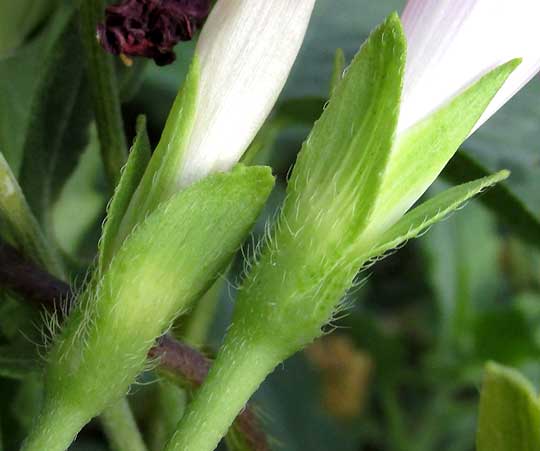
In that picture we see that the slender sepals partly overlap one another and are of different lengths. Below, they bear long, sharp, upward-turned, white hairs. These are all important field marks needed to determine the species.
During the blossom analysis, I didn't forget to pay attention to the pure beauty of the blossoms' colors. Just look at one view enjoyed below:
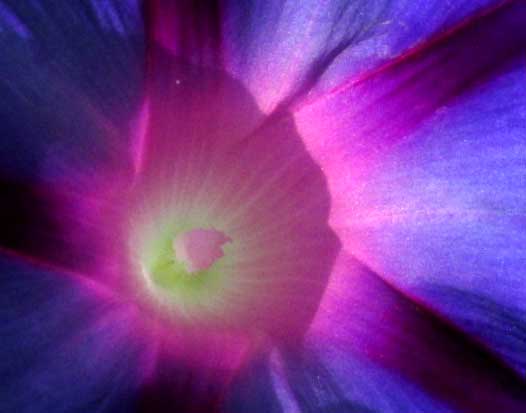
A longitudinal section of a blossom reveals that not only are the five stamens of very different lengths, but also that the stigma at the tip of the long, slender style is more or less spherical, though somewhat flattened. You can see this below:
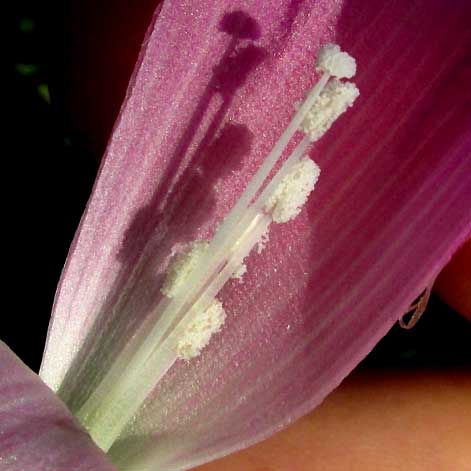
Such a roundish stigma helps us peg our morning glory as a member of the genus Ipomoea, the largest and most important of the Morning Glory genera, comprising over 500 species, among which the Sweet Potato is a very important member.
All the above field marks, especially the heart-shaped leaves, sepal shape and disposition, the forward-projecting hairs and the blossoms' white "eyes" giving way to a bluish outer corolla, lead us to IPOMOEA PURPUREA, commonly known as the Purple, Tall, or Common Morning Glory. If you do an image search on "Ipomoea purpurea" you'll see that the species' blossoms come in several colors, from deep blue to purple to rose, pink and white. Cultivars with white flowers ornamented with colored stripes also are available. However, the basic field marks remarked on here remain the same throughout the many cultivars.
Ipomoea purpurea is native to central and southern Mexico, though it's found growing in gardens as well as in the wild across North America, often "escaping" just like it apparently has at Phred's. However, as soon as Phred stops watering, I'll bet his morning glories will disappear.
entry dated August 23, 2022, issued from near Tequisquiapan; elevation about 1,900m, (6200 ft), ~N20.57°, ~W99.89°; Querétaro state, MÉXICO
THREE-LOBED LEAVES

Here I'm finding Ipomoea purpurea with deeply three-lobe leaves, as shown above. I read that they can be heart shaped, as seen in Texas, three lobed, or even five lobed. Otherwise, it's the very same species.
entry dated September 22, 2022, issued from near Tequisquiapan; elevation about 1,900m, (6200 ft), ~N20.57°, ~W99.89°; Querétaro state, MÉXICO
VARIEGATED FLOWERS

Along a narrow, dusty gravel road, the above morning-glory blossom easily got my attention from the shadows below a roadside jumble of Smooth Mesquites, Desert Hackberry and various weeds. You can get an idea of the blossom's size below:

The dusty leaf is malformed, and the flower unlike anything I'd seen. However, a look at the blossom's calyx opened the door to figuring out what was going on here:

For, the calyx with its lower part bearing long, stiff hairs with swollen bases, and the general form of the sepals, all said "Purple Morning-glory." Moreover, back at the computer, in every technical key I could find, despite the variegated corolla, the plant "keyed out" to "Purple Morning-glory." The Flora del Bajío even mentioned that on the calyx the long hairs' bases can be dark, which might explain the blackish speckles in the above picture.
The situation finally cleared up when I found the 2002 study by Shigeru Iida and others entitled "Floricultural Traits and Transposable Elements in Morning Glories." That paper carried a picture of a corolla looking exactly like ours, with the caption reading "A mutable flaked mutant in I. purpurea."
Our variegated blossom is a mutant. By "a mutable flaked mutant," reference is being made to a certain allele sometimes found on the chromosomes of certain individuals of the Purple Morning-glory. An allele is one of two or more alternative forms of a gene, caused by a mutation. However, this mutant allele, when present is only incompletely dominant, so as Purple Morning-glory generations pass, the variegated blossoms can come and go. I bet that the white streaks in the dark-blue flower shown in the image above, directly preceding this entry -- which I'd thought might be damage from an animal clawing its way toward the nectar -- is the mutable flaked mutant allele incompletely expressing itself.
We have many Purple Morning-glories here, but these mutants show up only infrequently. I asked a friend who has lived here for years if he'd seen such flowers, and he had, though only rarely. He remembered a certain place a few kilometers away, though, where they were more common.
The mutation is common enough that vines showing it are sold commercially under various names, such as the fancy sounding 'Carnevale de Venezia' form. Moreover, the "flaked mutant" turns up on the chromosomes of other morning-glory species as well, such as Ipomea nil and Ipomea tricolor. They show different patterns of variegation, but all are white with blue flakes and lines.
issued on September 11, 2020 in the valley of the Dry Frio River in northern Uvalde County, southwestern Texas, on the southern border of the Edwards Plateau; elevation ~1750m (~5750 ft); N29.62°, W99.86°; USA
POLLEN GRAINS
A Purple Morning Glory was resplendent with large, purple and blue blossoms. A small yellow smudge on the inside purple face of a flower's corolla was surely pollen knocked there by a visitor, and I thought: I wonder what that pollen looks like under the microscope? You can see a tiny part of the smudge below, showing pollen grains whose spiky surfaces help them stick to pollinators:

Several pollen grains were sticking to the flower's large, white stigma, shown below:

In that picture, possibly the pollen grain at the lower, right is germinating, issuing its pollen tube toward the stigma.